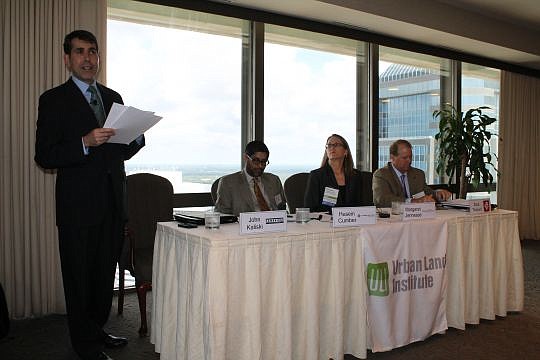
Getting Jacksonville’s Downtown better connected through public transit would lay the groundwork for regional high speed rail and help lift urban core real estate.
That was the takeaway of an industry panel that discussed the future of infrastructure in Northeast Florida.
The panel was part of a Tuesday event that unveiled the Urban Land Institute’s 2014 infrastructure report. The report focused on how infrastructure investments could shape cities for global competitiveness.
The industry panel took a local view, though, by asking which investments would promote Jacksonville the best. Downtown public transit connectivity was considered one of the missing puzzle pieces.
It’s one of the things holding back All Aboard Florida, a privately funded high-speed rail initiative that will connect Orlando with Miami. Jacksonville is not yet included in that plan.
The initiative is first targeting cities that have local routes in place to take riders from high-speed rail stations to their final destinations, said Husein Cumber, executive vice president of Corporate Development for the Florida East Coast Railway, the parent company of All Aboard Florida.
Orlando is one such city. It has been investing in its public
transportation system for decades.
To compete, Jacksonville would have to have routes in place so a rider could get from a high-speed rail station to places like EverBank Field for a game, to the airport, San Marco or Jacksonville Beach, Cumber said.
“If a person can’t easily get off our system and move to their end destination, when we do our ridership studies, the numbers are not going to come out as strongly,” he said.
FEC is investing $2 billion to create the first phase of All Aboard Florida, Cumber said. The project is viable because population growth is now headed away from suburbs and towards urban centers.
“When we think about an intra-city rail system, we need to have that density pick up, so that we can have a population to target and to pick up as riders,” Cumber said.
Margaret Jennesse, East Florida division president for GreenPointe Homes, is attached to the idea of developing Downtown.
“My wishes say, ‘Gosh I would like to invest every penny in Downtown residential, to get people living, working and playing Downtown,’” she said. “But the numbers are still not working.”
With the recovery, market demand in Northeast Florida has returned for same suburban product home builders have been making for 20 years. So that’s where investors are putting their money, she said.
Transit is one of the issues holding Downtown back, Jennesse said. A large employer a few years ago bypassed Jacksonville, because of weakness in public transit and education.
“We just haven’t bridged this gap yet,” she said.
The good news is Jacksonville is planning a major overhaul of its bus routes later this year.
Over the last 30 years, the public transit system has not kept up with employment and population shifts, said Brad Thoburn, vice president of Long Range Planning and System Development for the Jacksonville Transportation Authority.
“We have a lot of routes that are long, they meander and it takes a lot of time to get to where you want to go,” he said.
The new route system will make Jacksonville mass transit more reliable, frequent and direct, Thoburn said.
The city is also working on a grant application to extend the Skyway.
“It’s something we could build off of, so when we do commuter rail — which we are planning — the Skyway would become a circulator for Downtown that the commuter rail is connected to,” Thoburn said.
(904) 356-2466